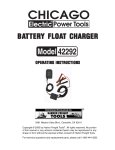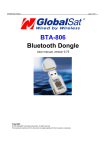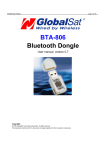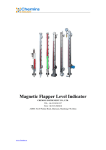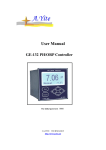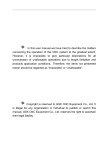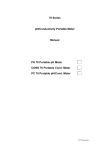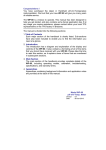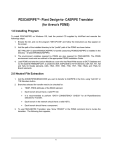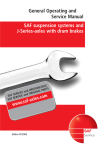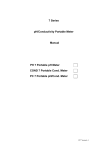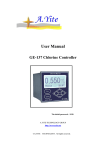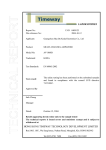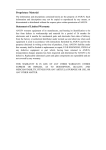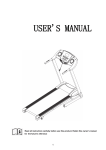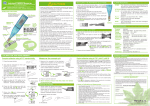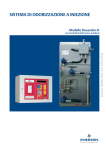Download PHG-200 Series PH Transmitter User Manual
Transcript
PHG-200 Series PH Transmitter User Manual PHG-201/202/203 YANTAI CHEMINS INSTRUMENT CO., LTD. TEL: +86 535 8381357 FAX: +86 535 2945018 Website: www.chemins-tech.com ADDR: No.68 Puzhao Road, Development Zone, Zhaoyuan, Shandong, China Index PHG‐200/ORP‐200 Series PH/ORP Transmitter User Manual (PHG‐201/202/203,ORP‐201/202) ........................................... 3 1. Typical applications ............................................................................................................................................... 3 2. Instrument characteristics..................................................................................................................................... 3 3. Product shape ....................................................................................................................................................... 3 4. Technical Specifications ......................................................................................................................................... 4 5. Installation instruction .......................................................................................................................................... 6 6. Configuration and settings .................................................................................................................................. 10 7. Maintenance ....................................................................................................................................................... 11 8. Packing list and accessories ................................................................................................................................. 12 9. Quality Assurance ............................................................................................................................................... 13 RS485 (Modbus/RTU) protocol ........................................................................................................................................... 13 www.chemins‐tech.com 2 / 15 PHG‐200/ORP‐200 Series PH/ORP Transmitter User Manual (PHG‐201/202/203,ORP‐201/202) 1. Typical applications z PHG-201: For PH on line measurement of swimming pool, aquatic farming, flower greenhouses, soilless cultivation and etc, very cost efficient. z PHG-202: For PH on line measurement of waste water treatment, pure water, drinking water, surface water, water supply, industrial sewage, cost efficient for basic industrial application. z PHG-203: For PH on line measurement of acid / alkali / salt solution, chemical reaction process, industrial manufacturing process, can satisfy most of industrial application requirement. 2. Instrument characteristics z Multiple signal output is optional: 4-20mA(2 wire analog), 0-2V(analog), Rs485(Modbus/RTU, digital). z Easy connect to PLC, industrial computer, controller, data logger or touch screen for online monitor and control. z Dual high-impedance differential amplifier, strong anti interference, fast response. z Patented pH probe, inner reference solution is promote by at least 100KPa pressure, extremely slow exudation. So that the potential is very stable long-termly, and the lifetime of the reference electrode several times than normal industrial probe. z The probe use gold plate VP header for plug connection. Threaded fastening, very easy to replace the probe. z Easy mounting. The 3/4” NPT thread is easy for pipe and tank mounting. The probe can be also separated with the display header, connect by cable. z IP65 protection level. 3. Product shape As to PHG-202 / 203, the middle one output analog signal, the right one output digital signal. PHG-202 and PHG-203 have the same shape like the right 2, just internal sensor, circuit and software are different. www.chemins‐tech.com 3 / 15 PHG-201 PHG-202 / PHG-203 4. Technical Specifications PHG-201 PHG-202 PHG-203 4-20mA (2 wire); Output signal 0-2V(option); (All isolated) Rs485(Modbus/RTU) (Option) www.chemins‐tech.com 4 / 15 LED model: 4 bits LED display. Just display PH value. LCD model: show pH value and temperature. Display 2 button for operation (LED model) 3 buttons for operation (LCD model) Operation Calibration 2 point calibration. Protection IP65 Scale 0~14pH Resolution 0.01pH ±0.05pH Accuracy 3/4" NPT thread Thread Auto PT1000 temperature (PT100 or other NTC resistor are optional) compensation 24VDC / 220VAC / 110VAC 24VDC 24VDC PHE-200 combined glass pH PHE-300 high performance electrode. combined glass pH electrode. Power supply Combined glass pH electrode. PHE-100 or 3rd part 120mm Electrode electrode. 3.0KCl electrolyte, re-fillable, 3.0KCl Gel electrolyte, can't long lifespan. be re-filled. 0.1MPa pressured(default); Electrolyte Temperature 0~65℃ 0~80℃ 3.0KCl electrolyte, re-fillable, long lifespan. 0.1MPa / 0.4MPa / 0.6MPa pressured (Optional); 0~80℃ (0~130℃ is optional) Pressure: <0.1MPa Atmosphere pressure. Atmosphere pressure. (0.6MPa and even higher pressure is optional) Pressure Reference POM fiber salt bridge Ceramic salt bridge Ceramic salt bridge Case NYLON NYLON PPS About 1 year. About 1.5 year. About 1.5 ~ 2 year. Estimated lifespan of electrode www.chemins‐tech.com 5 / 15 5. Installation instruction Wiring Other installation www.chemins‐tech.com 6 / 15 Sanitary model www.chemins‐tech.com 7 / 15 www.chemins‐tech.com 8 / 15 High pressure model www.chemins‐tech.com 9 / 15 6. Configuration and settings A. Calibration of PH transmitter The transmitter can use US/NIST(4.01,7.00,10.01) and DIN(4.00,6.86,9.18) buffer solution for calibration. Below context take pH 4.00, 6.86, 9.18 standard buffer solution (value in 25℃) as example. Please note that after calibration in one kind of solution and before calibrate in another solution, we must use the latter solution to clean the probe, otherwise it will introduce a lot of test error. Zero calibration Power on the transmitter, put the electrode into the buffer solution (6.86pH). Screen displays the current pH, the transmitter output is 12mA (4-20mA). Please be note the displayed pH value had been compensated with the medium temperature. To eliminate the error, adjusting the positioning potentiometer. (Tune of "O" in the circuit potentiometer clockwise to increase, counterclockwise to decrease). Slope calibration Power on the transmitter, put the electrode into the buffer solution (4.00pH as first). The screen shows the current measured pH value (this value is modified through the zero calibration). After the measured pH value is stable, the transmitter output is 4.01 × 1.142 +4 = 8.58mA (4-20mA). To eliminate the error by adjusting the slope of the potentiometer. (The "S" in the tone circuit on the potentiometer). Put the electrode into the buffer solution (9.18pH). After the measured pH value is stable, the transmitter output should be 9.18 × 1.142 +4 = 14.48mA (4 - 20 mA). To eliminate the error by adjusting the slope of the potentiometer. (The "S" in the tone circuit on the potentiometer). B. Calibration of ORP transmitter Please note that after calibration in one kind of solution and before calibrate in another solution, we must use the latter solution to clean the probe, otherwise it will introduce a lot of test error. Zero calibration Power on the transmitter, put the electrode into the buffer solution. Screen displays the current mV value. To eliminate the error, adjusting the positioning potentiometer. (Tune of "O" in the circuit potentiometer clockwise to increase, counterclockwise to decrease). Slope calibration Power on the transmitter, put the electrode into another buffer solution. The screen shows the current measured mV value. After the measured mV value is stable, eliminate the error by adjusting the slope of the potentiometer. (The "S" in the tone circuit on the potentiometer). Calibrate the zero and slope point several times to ensure better accuracy. www.chemins‐tech.com 10 / 15 C. Take into use After take out the instrument from the box, check if there is any damage, leakage and loosening part.(It’s normal that there is salt crystallization phenomenon near the reference salt bridge outside of the glass electrode). After wiring is completed, tightening the screws of the junction box to ensure a good seal. (Serious moisture will cause the output to be abnormal.) Placed the probe in clean water, the displayed value should be about 7 pH. Due to the transport process, air bubbles will be accumulated inside of bulb of the electrode, it will cause abnormal measurement result. At this point, lift the sensor to be upright, hand tapping the sensor until can’t see the bubbles in the probe. Add few acid to the clean water, the pH value should be obviously lower, it means the sensor become normal. Do not take the sensor into use immediately, please soak it for more than 24 hours. So that the imbalance potential will be reduce, and it can be take into use after re-calibration. 7. Maintenance Periodic inspection of the instrument should be based on media situation. If the media situation is good, then inspection can be taken every six months. In scaling or polluted media, inspection should be took every month or every week, even if the sensor is equipped with automatic cleaning device. The bottom of the transmitter junction boxes is the reference solution slot, it contact with media through the salt bridge. If the sensor is with pressure compensation device, should be noted that the pressure indication can not be lower than the medium pressure, to prevent media back flow which will cause pollution to the reference electrode. In this case, periodic pneumatic compression is needed. Why must soak the pH electrode before take into use? The PH bulb is a special glass membrane. There is a thin layer of hydrated gel layer in the glass membrane surface. After fully and enough soak, a stable H+ layers will be formed on the membrane surface. If soaking does not fully and enough, the response value will be unstable and drift during measurement. 24 hours is enough when soaked in 3Mol KCL solution. The main reason of electrode error and how to handle. Stable reference system is the key for the stable and long life of the electrode. Following reason will significantly affect the pH electrode performance: The Cl- ion loss on the liquid junction of the reference; pollution; membrane blocking. This problem can only be resolved by re-calibrate the electrode. However, even after good calibration, the on line measurement may not be accurate too. If the media pressure is greater than the reference electrolyte pressure inside the electrode, it will result in reverse osmosis. Reverse osmosis will pollute the electrode reference system seriously, it will result in inaccurate result, and even electrode scrap. To avoid this problem effectively? Our company take following innovative design for the pH sensor: ¾ Filling pressure: the inner pressure make the reference solution is always positive direction outward penetration to avoid contamination. ¾ Increase the capacity of reference system: to ensure that longer oozing time. www.chemins‐tech.com 11 / 15 ¾ Reduce the amount of exudation: to ensure a longer oozing time ¾ Dual high-impedance measurement circuit: to ensure a reliable reference signal when the reference electrode oozing slowly. The relation between temperature and the PH value of the standard buffer solution Temperature pH value ℃ 0.05M 0.025M Potassium hydrogen phthalate Mixed phosphate 10 4.00 6.92 15 4.00 6.90 20 4.00 6.88 25 4.00 6.86 30 4.01 6.85 35 4.02 6.84 40 4.03 6.84 45 4.04 6.83 50 4.06 6.83 0.01M Borax 9.33 9.28 9.23 9.18 9.14 9.10 9.07 9.04 9.02 Glass electrode is a consumable, the life cycle is about one year or so. The lifetime of the electrode based on maintenance situation and the measured medium. In bad media or poor maintenance, the lifetime of the electrode will be greatly reduced. Therefore, the electrode need to be replaced with new one. Electrode replacement is easy as below picture: 8. Packing list and accessories Packing list: www.chemins‐tech.com 12 / 15 z Instrument which include sensor. z A set of 3 bags of pH buffer, can be used to make standard buffer solution. pH value is 4.00, 6.86, 9.18 (in 25℃). z 1 copy of user manual. z Thredolet (optional) pH buffer is a consumable item, not in warranty. 9. Quality Assurance This product is one-year warranty, from date of delivery. Product warranty does not cover damage caused by improper usage. If need repair, please return and take the freight cost. Good packaging is required to avoid transportation damage. Glass electrode lifespan is related to usage environment, not in warranty issue. RS485 (Modbus/RTU) protocol This meter/transmitter adopts ModBus-RTU communication protocol. The communication baud rate is 9600bps. 1. Word Format: 1 Start bit +8 bit Data + 1 Even Parity Check bit +1 Stop bit, totally11bit. 2. Frame Structure: Address Code (1Byte) + Function Code (1Byte) + Code (2Byte). Data segment (n Byte,) + CRC Check The transmission of message frame start at least a pause interval of 3.5 bytes’ time. The entire message frame must be transmitted as a continuous stream. If there is more than pause of 3.5 bytes’ time, the receiving device will treat the transmission of the current message frame is end, and assume that the next received byte is the start of the new frame byte. Address Code: The address of slave device, ranging from 0 to 255. It can be set through the menu, the factory default is 6. Function Code: The standard ModBus communication protocol defined function codes 1-127. This meter / transmitter only use the 03 (read the data of register) function code to read the data of register. Data segment: The host use function code 03 to inform the slave send back the specified length data from the specified register (Message frame contains the length of the start address of the register, and the length of data of the register). The returned data from the slave includes the data length and data content. The address, length and data are all hexadecimal, the high byte first and the low byte last. CRC Check Code: hexadecimal, 3. low byte first and high byte last. Communication example (the slave address is 6): 3.1 Reading main measured values (the start address of register is 0x0101) www.chemins‐tech.com 13 / 15 The sent frame of Host device Address Function Start address Quantity Code Code of the register of the register 06 CRC16 High Low High Low Low High 01 01 00 02 95 80 03 The response frame of Slave device Address Function Length Data Code Code of data byte 06 03 04 XX XX CRC16 00 0X XX XX 3.2 Reading temperature value (the start address of register is 0X0103) The sent frame of Host Device Address Function Start address Quantity Code Code of the register of the register 06 CRC16 High Low High Low Low High 01 03 00 02 34 40 03 The response frame of Slave Device Address Function Length Code Code of data byte 06 03 04 Data XX XX CRC16 00 01 XX XX Note: The host should read the values of two registers each time. The returned 4 bytes from the slave is as complete instrument data. The first 2 bytes representing the data (in the form of complement, the highest bit is sign bit), the last 2 bytes indicating the position of decimal point or the number of decimal (the decimal of temperature is fixed to 1, means temperature shows like 20.1). www.chemins‐tech.com 14 / 15 Thanks for your support to our products! YANTAI CHEMINS INSTRUMENT CO., LTD. TEL: +86 535 8381357 FAX: +86 535 2945018 Website: www.chemins-tech.com ADDR: No.68 Puzhao Road, Development Zone, Zhaoyuan, Shandong, China www.chemins‐tech.com 15 / 15















